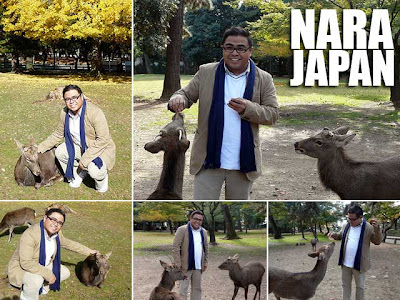
Autumn in
Kyoto, Japan attracts throngs of tourists every year to its temples and other historic monuments. And we're lucky that our conference coincided with the vivid colors of Japan's autumnal foliage. We arrived in the evening so we did not get to see those autumn colors and Mount Fuji while on the Shinkansen.
Tired from going around Tokyo the whole day, our group decided to go straight to the
Kyoto Utano Youth Hostel where we had booked our stay for the next three nights. It's about an hour from the train station but only one bus ride on Bus No. 26. So we got to rest on the bus. But once we got there, we knew we made the right choice since for a youth hostel, this one was grand! A bed is Y3300 a night. You can also opt to have breakfast there for Y600.
The next day, we purchased one-day bus passes at the hostel counter for Y500 which is a must if you want to maximize your stay in Kyoto. Make sure you get a copy of the bus map the night before you go around so that you can plan which buses to take and where to go next.

There were so many temples to visit, many of the UNESCO World Heritage Sites. But each had its own entrance fee. So people on a tight budget have to plan their trip around Kyoto wisely.
Our first stop was
Ninna-ji since it was the closest to our youth hostel. It once served as the old imperial palace of Omuro, a residence for the former emperor. The temple is most noted as the center of the Omuro school of the Shingon sect of Buddhism. To visit the grounds, we had to pay Y500. We actually chanced upon a period movie being shot on the grounds. I had wanted to take photos of the actors in costume but the crew was very strict and did not allow photos to be taken.

We again hopped on the bus to get to our next stop, a must visit when in Kyoto,
Kinkaku-ji. Kinkaku-ji is the popular name of
Rokuon-ji Temple, home of the golden pavilion, an iconic attraction of Kyoto. It was exciting seeing the gold colored structure by the man-made lake for which I had only seen before in pictures. To get in, you have to pay Y400.
 Nijo Castle
Nijo Castle was our stop before a very late lunch. Since we wanted to visit as much as we could while the sun was out (it looked like it was going to rain), we decided to delay our lunch break until we got to
Gion.
Built in 1603 as the official Kyoto residence of the first Tokugawa shogun, Ieyasu, the castle was completed in 1626 by third Tokugawa shogun Iemitsu. It is one of the finest examples of Momoyama architecture in Japan, making use of early Edo building designs. Entrance ticket is Y600.

Gion is very popular with tourists so that’s where we decided to have lunch. Gion is a district of Kyoto that originally developed in the Middle Ages to accommodate needs of travelers and visitors to the
Yasaka Shrine. It became one of the most exclusive and well-known Geisha districts in all of Japan. So visiting this place is a must for people who want to see old architecture and the traditional way of the geisha.


Our last stop before the sun went down was
Kiyomizudera, another iconic attraction of the city. From the temple, you get a panoramic view of Kyoto. You can get perfect sunset shots from there. Ticket price is Y300. Shortly after sunset, they let all the visitors out of the grounds. And you can wait to re-enter again, this time for the evening views of Kyoto. It’s a different entrance fee for this but since we wanted to go back to the hostel and rest, we decided to make our way down the hill, passing by the many colorful souvenir and snack shops along the way.
Kyoto Utano Youth Hostel29 Nakayama-cho Uzumasa
Ukyo-ku, Kyoto-shi, Kyoto-fu 6
Kyoto 616-8191 Japan
+81 75 462-2288






















